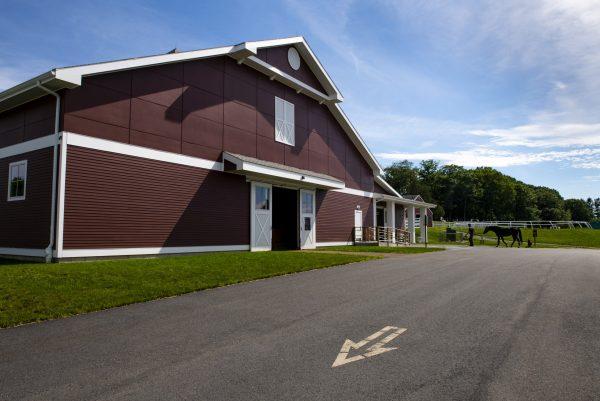-
About
- Leadership & Faculty
- News & Events
-
Academics
- Graduate
- Advanced Clinical Training
- Continuing Education
-
Student Life
-
Research
-
Hospitals & Clinics
- Emergency Care
- Hospital Services
-
Community Outreach
- Volunteer
Tufts Equine Center Focuses on Special Bond Between Horse and Rider
Cross-specialty collaboration is a mainstay at the Grafton facility

“There’s a unique bond between a horse and its owner. Most dogs are companions, a horse is your teammate. We recognize the different and special relationship on the equine side,” explains Dr. Thomas Jenei, V02, director of the Hospital for Large Animals (HLA) at Cummings School of Veterinary Medicine at Tufts University.
The HLA includes Tufts Equine Center and the Fiber and Farm Service. Since 1979, HLA has provided consultation, referral, and emergency veterinary care for patients.
According to Jenei, about 85 percent of HLA patients are horses seen in the Equine Center, and 15 percent are alpacas, llamas, goats, sheep, and pigs treated in the Farm and Fiber Service.
“Farm animals are an underserved group. Many don’t have a primary care veterinarian, so we’re ready and willing to help them,” Jenei states.
The Tufts Equine Center offers routine and specialized services for horses, including sports medicine, surgery, internal medicine, and imaging. All of the clinicians are professors at Cummings School, and each are board-certified in one or more areas of specialty care.
“The clinicians are the foundation of Tufts Equine Center, collectively providing specialty services across the spectrum,” Jenei contends.
Jenei has worked at HLA since 2002 as an intern, resident, emergency care clinician, and currently, as head of the General Surgery Service with Dr. Carl Kirker-Head. The types of surgeries they most often perform include management of traumatic injuries, surgical oncology, gastrointestinal procedures, and advanced reproductive surgeries, such as removing ovaries in mares or complicated castrations for stallions.
Drs. José García-López and Kirstin Bubeck lead the Equine Sports Medicine Service, focusing on the treatment of horses with performance issues (lameness). They utilize a variety of traditional and advanced diagnostic tools to accurately identify musculoskeletal problems. This includes advanced imaging modalities such as MRI, Nuclear Scintigraphy, and CT scans, along with routine radiographs and ultrasound. As Drs. García-López and Bubeck are each board-certified in sports medicine and surgery, they follow through and provide interventional procedures, such as arthroscopy, to speed their patients toward recovery.
The Internal Medicine team is headed by two clinicians who are world renowned in the field of equine pulmonology, Drs. Melissa Mazan, V93, and Daniela Bedenice. They are currently investigating new treatment options for equine asthma and how the gut and respiratory microbiome can be harnessed as a resource for establishing novel therapies in a variety of clinical conditions.
“Dr. Mazan and Dr. Bedenice’s research is advancing the science in the area of critical care and respiratory disease management of horses,” Jenei asserts.
The Imaging team, led by ultrasonographers Drs. Wade Tenney and Kate Chope, are essential to the other services. Each has a strong interest in musculoskeletal diseases, and like Drs. García-López and Bubeck, both are board-certified specialists in sports medicine.
“What they provide from a diagnostic perspective is critically important,” Jenei claims. “Ultrasound allows us to noninvasively assess and analyze what’s going on with the horse to guide treatment recommendations and when needed, assist in interventional steps in the care or treatment of the underlying condition.”
Jenei explained that if a horse has arthritis affecting the joints of their neck that would benefit from injection of anti-inflammatory medications, ultrasound can be used to ensure the needle is safely positioned into the joint. Similarly if a biopsy of the liver or kidney is required, this can be performed in a minimally invasive manner without the need for surgery.
“The ultrasound faculty are unsung heroes, with extensive clinical experience who provide imaging expertise that supports and facilitates the care of our horses,” says Jenei.
HLA draws on additional experts within Cummings School and the greater Tufts community when needed. Faculty from Foster Hospital for Small Animals in the areas of cardiology, neurology, dermatology, and oncology, are available to consult on complex cases. The Tufts Equine Center also benefits from the expertise of Dr. Stephanie Pumphrey, V08, a boarded ophthalmologist, to provide both medical and surgical management of complex eye injuries.
Tufts Equine Center uses state-of-the-art facilities, equipment, and technologies. The Equine Sports Medicine Complex and arena allows horses to be seen in settings most conducive to assessing and providing care. Horses with infectious diseases are treated in the Isolation Facility, for example. Two recently acquired technologies include the Equinosis Lameness Locator System, to more accurately and safely pinpoint joint issues, and the Optomed Dynamic Respiratory Scope, to diagnose respiratory issues while a horse is in motion and without the need for a treadmill.
During the pandemic, the staff at HLA adjusted to a new normal and increased demand for care.
“We were glad to see that even in the face of the pandemic, people were still entrusting us with the care of their horses,” Jenei acknowledges.
Especially challenging were restrictions put in place that limited access of owners to HLA and to participate in their horses’ care. Veterinarians typically visit horses on the farm, and when they’re referred to HLA, owners often accompany their horses during treatments and procedures, he explains.
“It’s a different experience between large and small animals, owners are used to being present,” Jenei shares. “We’re gradually working back to a more open-door approach. We’re not 100 percent back to normal yet, but there is better access now for clients.
“The core part of what we do is recognizing that unique relationship between the owner and the horse. We have specialists who are focused and determined to provide care to that team—the rider and the horse.”